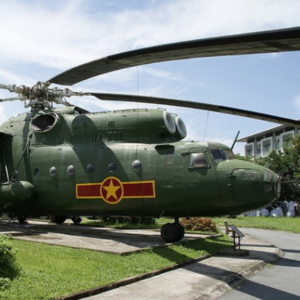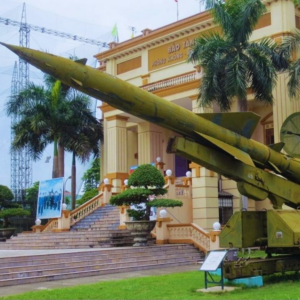Air Force and Air Defence Museum – Hanoi’s Sky-Defence Legacy
Air Force and Air Defence Museum – Unveiling Vietnam’s Aerial Strength
Imagine standing face-to-face with mighty fighter jets and anti-aircraft guns that once protected Vietnam’s skies. That’s exactly what you’ll find at the Air Force and Air Defence Museum in Hanoi. Whether you’re a history lover, a curious traveler, or just want a glimpse of Vietnam’s powerful past, this museum promises a fascinating experience for all ages.
About Air Force and Air Defence Museum

Air Force and Air Defence Museum is a military history museum in Hanoi that focuses on Vietnam’s aerial warfare and defensive strategies. It houses a variety of real fighter jets, missile systems, uniforms, diaries, and other personal items from pilots and soldiers who defended the country’s skies. Located on Truong Chinh Street, it offers visitors an up-close look at how Vietnam built, maintained, and improved its air force throughout different periods of conflict and modernization. This museum stands out as a must-see tourism site for history buffs, aviation enthusiasts, and anyone interested in learning about the bravery and innovation of Vietnam’s air defenders.
Main Exhibition Zones at Air Force and Air Defence Museum
– Outdoor Display Area
- Fighter Jets & Helicopters
See real aircraft like MiG fighters, helicopters, and older propeller planes used in major campaigns. - Air Defence Weaponry
Explore anti-aircraft guns, missile launchers (SAM), and radar trucks that played key roles in safeguarding Vietnam’s skies. - Captured/Downed Enemy Aircraft Remains
Witness pieces of US bombers and other foreign aircraft brought down during past wars, representing the courage and skill of Vietnam’s air defenders.
– Indoor Historical Galleries
- Formation & Evolution of the Air Force
Learn how Vietnam built its aerial defense forces, from the earliest days to modern developments. - Key Military Campaigns
Displays showing significant operations, battles, and achievements, with mission maps and tactical diagrams. - Pilot & Soldier Artifacts
Personal items such as flight suits, medals, photos, letters, and diaries telling the individual stories behind the broader conflicts.
– Memorial & Recognition Corner
- Tribute to Heroes
A dedicated space honoring the lives and valor of fallen pilots, ground crew, and anti-aircraft personnel. - Hall of Fame
Showcasing notable figures who received prestigious military honors for outstanding service.
– Interactive/Multimedia Sections
- Documentary Screens
Short films, news clips, and interviews explaining major air defense milestones and war events. - Simulated Radar or Cockpit Models
Some areas may feature hands-on elements or re-created command centers, enabling visitors to imagine operating the radar or aircraft.
– Temporary Exhibitions
- Special Themed Displays
Rotating sections focusing on specific time periods, new research findings, or spotlighting modern air force developments. - Commemorative Events
Occasional exhibits during anniversaries or major celebrations related to Vietnam’s air defense history.
Why This Museum Is Special for Visitors
– Genuine War Artifacts: See real warplanes, missile launchers, and other technology used in key conflicts, giving you a rare, authentic look at Vietnam’s air defense capabilities.
– Personal Stories & Relics: View uniforms, medals, diaries, and photographs from actual pilots and soldiers, which bring to life the human side of military history.
– Educational & Kid-Friendly: Learn about different eras of warfare, how technology evolved, and the role of teamwork in protecting Vietnam’s skies. Children especially enjoy seeing the big planes and interactive exhibits.
– Less Crowded, More Immersive: Compared to central museums, it’s often quieter, allowing a calmer, more focused exploration of exhibits and a deeper connection with the stories.
– Comprehensive Perspective on Aerial Defense: From the earliest days of Vietnamese aviation to modern strategies and equipment, the museum covers a broad, fascinating scope of air defense history.

How to Plan Your Visit
– Location & Access
- The museum is located at 171 Truong Chinh Street in Hanoi, roughly 5 km from the city center.
- You can reach it by bus along Truong Chinh (routes like #03, #16, #21) or by taxi/Grab in about 15 minutes from the Old Quarter.
– Opening Hours & Tickets
- Generally open from 8:00 AM to 4:30 PM on weekdays (with a midday break, usually 11:30 AM–1:00 PM).
- Closed on weekends, so always double-check current schedules.
- Admission is typically inexpensive or even free for certain visitor groups.
– Recommended Time & Itinerary
- Plan on spending 1–2 hours to see both indoor and outdoor exhibits.
- Start outside with the planes and missile systems, then move inside to explore maps, diaries, and personal artifacts.
- If you have extra time, combine this visit with the nearby Military History Museum or Hanoi Flag Tower for a fuller historical tour.
– Tips for a Better Experience
- Dress appropriately – it’s a military-related site, so modest attire is recommended.
- Ask staff for detailed stories or clarifications; they can offer fascinating insights.
- Respect any photography restrictions, especially around high-security zones.
Recommended Itinerary
- Arrival (Morning or Early Afternoon)
- Arrive around 8:00–9:00 AM (or just after lunch if you prefer afternoons) to avoid any midday closures and have fewer crowds.
- Check at the ticket desk if there are any special exhibits or guided tours happening that day.
- Outdoor Display (30–40 Minutes)
- Start by exploring the planes, helicopters, and missile launchers in the courtyard.
- Take photos with the iconic MiG fighters or radar systems.
- Read signboards to learn about each aircraft’s history and the missions they served.
- Indoor Galleries (45–60 Minutes)
- Move inside to the main exhibition halls, following the historical timeline from the early days of the Air Force to modern developments.
- See personal items like uniforms, medals, and diaries, offering a human touch to the military artifacts.
- Spend extra time at the campaign maps or interactive displays if available.
- Memorial Corner (10–15 Minutes)
- Pause briefly at the memorial area honoring fallen heroes.
- Observe a moment of respect for those who sacrificed to protect Vietnam’s skies.
- Optional Extension (30 Minutes)
- If time permits, watch short documentary films if the museum has a media room or any ongoing presentation.
- Browse the gift shop for books or postcards related to Vietnam’s air defense history.
- Wrap-Up
- Check if there’s a small café or refreshment stand on-site. If not, nearby streets often have local eateries where you can try Vietnamese snacks or coffee.
- Combine your museum visit with another historical site like the Vietnam Military History Museum or Hanoi Flag Tower to continue your exploration of Vietnam’s military heritage.

Conclusion
Air Force and Air Defence Museum offers more than just planes, radars, and missiles – it presents real-life stories of courage and national pride that shaped Vietnam’s aerial defense. Walking through its exhibits brings you closer to the brave pilots, soldiers, and engineers who protected the nation’s skies. It’s a journey into the heart of Vietnam’s spirit, where history and humanity connect in each display.
Looking for a unique slice of Vietnam’s history? Add Air Force and Air Defence Museum to your Hanoi itinerary – and witness firsthand the technology, bravery, and determination that soared above Vietnam’s skies. Plan your visit with VNITourist for helpful tips and local insights.

